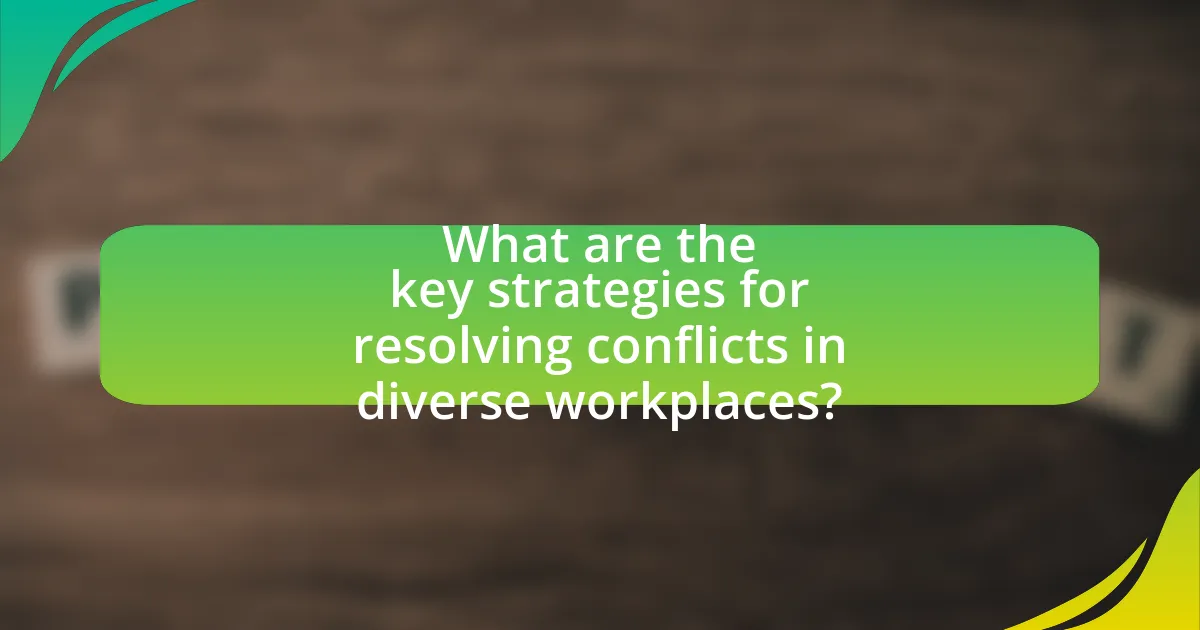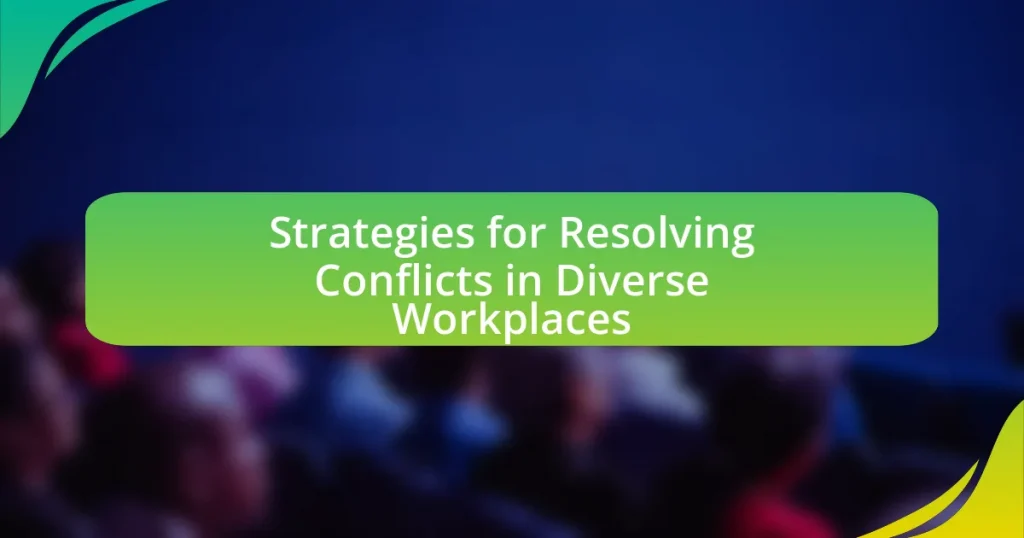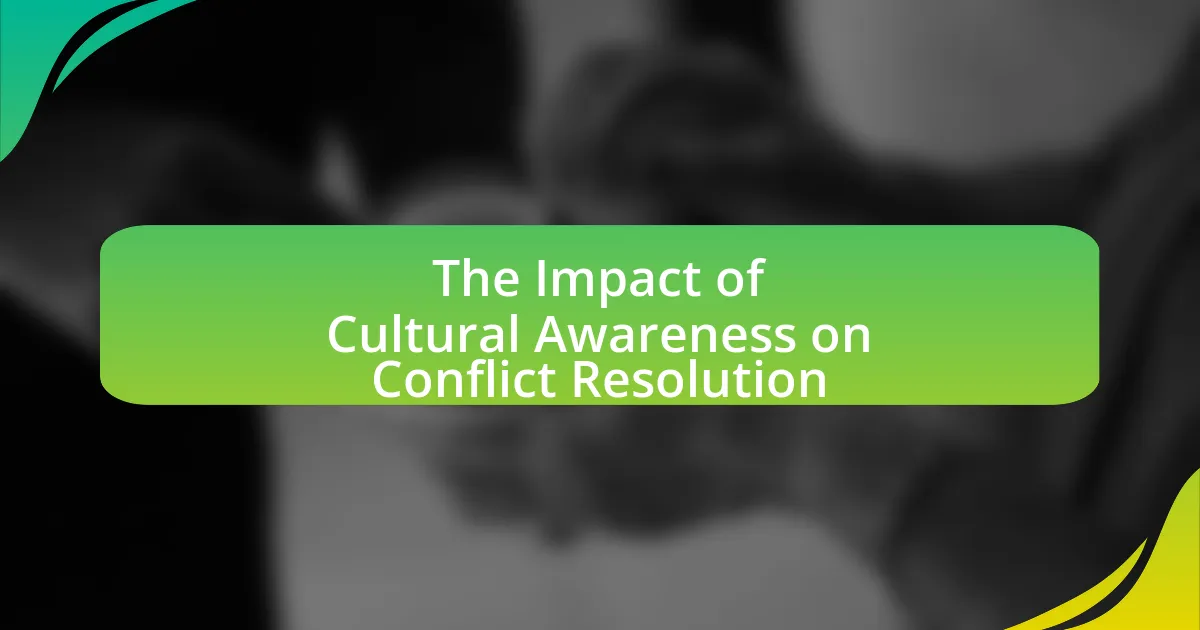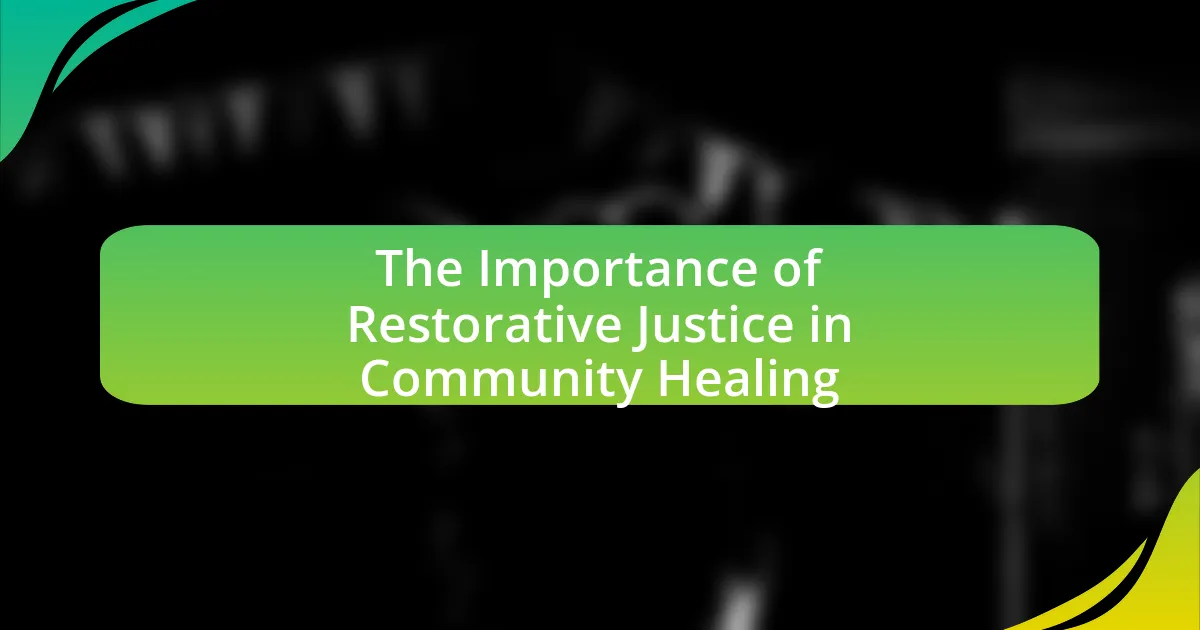The article focuses on strategies for resolving conflicts in diverse workplaces, emphasizing the importance of open communication, cultural awareness, and mediation processes. It explores how cultural differences influence conflict resolution strategies, highlighting specific factors such as communication styles and power distance that must be considered. The role of effective communication in mitigating conflicts is discussed, along with the benefits of involving all parties in the resolution process. Additionally, the article outlines common conflict resolution models, the significance of leadership in facilitating resolution, and best practices for preventing conflicts, ultimately providing practical tips for fostering harmony in diverse teams.

What are the key strategies for resolving conflicts in diverse workplaces?
Key strategies for resolving conflicts in diverse workplaces include fostering open communication, promoting cultural awareness, and implementing mediation processes. Open communication allows employees to express their concerns and perspectives, which is essential in a diverse environment where misunderstandings can arise from differing cultural backgrounds. Promoting cultural awareness through training helps employees understand and appreciate diversity, reducing biases and fostering respect. Mediation processes, facilitated by trained professionals, provide a structured approach to conflict resolution, ensuring that all parties are heard and that solutions are collaboratively developed. These strategies are supported by research indicating that effective communication and cultural competence significantly enhance workplace harmony and productivity.
How do cultural differences impact conflict resolution strategies?
Cultural differences significantly impact conflict resolution strategies by influencing communication styles, negotiation approaches, and perceptions of authority. For instance, collectivist cultures often prioritize group harmony and consensus, leading to indirect communication and avoidance of confrontation, while individualistic cultures may favor direct communication and assertiveness in addressing conflicts. Research by Hofstede indicates that cultural dimensions, such as power distance and uncertainty avoidance, shape how individuals approach conflict resolution. In high power distance cultures, subordinates may defer to authority figures, affecting the resolution process, whereas low power distance cultures encourage egalitarian dialogue. These variations necessitate tailored conflict resolution strategies that consider cultural contexts to enhance effectiveness and foster collaboration in diverse workplaces.
What specific cultural factors should be considered in conflict resolution?
Specific cultural factors that should be considered in conflict resolution include communication styles, power distance, individualism versus collectivism, and conflict avoidance versus confrontation. Communication styles vary across cultures; for instance, high-context cultures rely on non-verbal cues and implicit messages, while low-context cultures prioritize direct verbal communication. Power distance reflects how different cultures perceive authority and hierarchy, influencing how conflicts are approached and resolved. Individualistic cultures emphasize personal goals and autonomy, whereas collectivist cultures prioritize group harmony and consensus, affecting conflict resolution strategies. Additionally, some cultures may prefer avoiding conflict altogether, while others may encourage open confrontation, impacting the resolution process. Understanding these factors is crucial for effective conflict resolution in diverse workplaces, as they shape individuals’ perceptions and behaviors during conflicts.
How can understanding cultural backgrounds improve conflict outcomes?
Understanding cultural backgrounds can significantly improve conflict outcomes by fostering empathy and enhancing communication among individuals from diverse backgrounds. When parties involved in a conflict recognize and appreciate each other’s cultural perspectives, they are more likely to engage in constructive dialogue, reducing misunderstandings and promoting collaboration. Research indicates that culturally aware teams demonstrate higher levels of trust and cooperation, which are essential for effective conflict resolution. For instance, a study published in the Journal of Cross-Cultural Psychology found that teams with high cultural intelligence were 30% more effective in resolving conflicts compared to those with low cultural awareness. This evidence underscores the importance of cultural understanding in achieving positive conflict outcomes.
What role does communication play in resolving workplace conflicts?
Communication is essential in resolving workplace conflicts as it facilitates understanding and collaboration among employees. Effective communication allows individuals to express their perspectives, clarify misunderstandings, and negotiate solutions. Research indicates that organizations with strong communication practices experience 47% higher employee engagement, which directly correlates with reduced conflict and improved resolution outcomes. Furthermore, open dialogue fosters a culture of trust, enabling team members to address issues proactively rather than reactively, ultimately leading to a more harmonious work environment.
How can effective communication techniques mitigate conflicts?
Effective communication techniques can mitigate conflicts by fostering understanding and collaboration among individuals. When parties engage in active listening, they demonstrate respect for differing viewpoints, which can reduce tension and promote empathy. Research indicates that organizations employing structured communication strategies, such as regular feedback sessions and conflict resolution training, experience a 25% decrease in workplace disputes. This evidence underscores the importance of clear, open dialogue in resolving misunderstandings and building stronger relationships in diverse workplaces.
What are the barriers to effective communication in diverse teams?
Barriers to effective communication in diverse teams include language differences, cultural misunderstandings, and varying communication styles. Language differences can lead to misinterpretations and hinder clarity, as team members may not share a common language or proficiency level. Cultural misunderstandings arise from differing norms, values, and expectations, which can create confusion and conflict. Additionally, varying communication styles, such as direct versus indirect communication, can result in misalignment and frustration among team members. Research indicates that these barriers can significantly impact team performance and collaboration, highlighting the need for strategies to address them effectively.
Why is it important to involve all parties in conflict resolution?
Involving all parties in conflict resolution is crucial because it ensures that diverse perspectives are considered, leading to more comprehensive and effective solutions. When all stakeholders participate, they contribute their unique insights and experiences, which can help identify the root causes of the conflict and foster mutual understanding. Research indicates that inclusive conflict resolution processes can enhance collaboration and trust among team members, ultimately improving workplace dynamics and productivity. For instance, a study published in the Journal of Conflict Resolution found that inclusive approaches significantly reduce the likelihood of future conflicts by promoting a sense of ownership and accountability among all parties involved.
What are the benefits of collaborative conflict resolution approaches?
Collaborative conflict resolution approaches enhance relationships and foster a positive work environment. These methods encourage open communication, allowing parties to express their needs and concerns, which leads to mutual understanding. Research indicates that organizations employing collaborative strategies experience a 30% increase in employee satisfaction and a 25% reduction in turnover rates. Additionally, collaborative conflict resolution promotes creative problem-solving, as diverse perspectives are integrated, resulting in innovative solutions that benefit the organization as a whole.
How can inclusivity enhance the resolution process?
Inclusivity enhances the resolution process by fostering a collaborative environment where diverse perspectives are valued and integrated. When all parties feel included, they are more likely to share their viewpoints, leading to a comprehensive understanding of the conflict. Research indicates that inclusive teams are 1.7 times more likely to be innovative and 1.8 times more likely to be change-ready, which directly contributes to effective conflict resolution. This diversity of thought allows for creative solutions that may not emerge in a less inclusive setting, ultimately leading to more sustainable resolutions.
What are some common conflict resolution models used in diverse workplaces?
Common conflict resolution models used in diverse workplaces include the Interest-Based Relational Approach, the Thomas-Kilmann Conflict Mode Instrument, and the Collaborative Problem Solving model. The Interest-Based Relational Approach emphasizes maintaining relationships while addressing the underlying interests of conflicting parties, which is crucial in diverse environments where cultural sensitivities may vary. The Thomas-Kilmann Conflict Mode Instrument categorizes conflict resolution styles into five modes: competing, accommodating, avoiding, collaborating, and compromising, allowing individuals to understand their preferred styles and adapt to others’ approaches. The Collaborative Problem Solving model focuses on mutual problem-solving and creativity, fostering an inclusive atmosphere that values diverse perspectives. These models are effective as they promote understanding and cooperation among individuals from varied backgrounds, ultimately leading to more sustainable resolutions.
How does the interest-based relational approach work?
The interest-based relational approach works by prioritizing the underlying interests of all parties involved in a conflict rather than focusing solely on their positions. This method encourages open communication, collaboration, and mutual respect, allowing individuals to identify shared goals and find solutions that satisfy everyone’s needs. Research indicates that this approach fosters a more positive workplace environment, as it reduces adversarial interactions and promotes cooperative problem-solving, ultimately leading to more sustainable resolutions.
What is the role of mediation in resolving workplace conflicts?
Mediation plays a crucial role in resolving workplace conflicts by facilitating communication and negotiation between conflicting parties. This process allows individuals to express their concerns and perspectives in a structured environment, promoting understanding and collaboration. Research indicates that mediation can lead to a higher rate of resolution compared to traditional conflict resolution methods, with studies showing that approximately 70% of mediated disputes reach a satisfactory agreement for all parties involved. By providing a neutral third party to guide the discussion, mediation helps to de-escalate tensions and fosters a more amicable workplace atmosphere.
How can leaders facilitate conflict resolution in diverse teams?
Leaders can facilitate conflict resolution in diverse teams by promoting open communication and fostering an inclusive environment. By encouraging team members to express their perspectives and actively listening to each viewpoint, leaders create a space where all voices are heard. Research indicates that diverse teams can outperform homogeneous ones when managed effectively, as they bring varied insights that enhance problem-solving (Herring, 2009, “Does Diversity Pay? Race, Gender, and the Business Case for Diversity”). Additionally, implementing structured conflict resolution processes, such as mediation or facilitated discussions, can help address issues systematically and fairly. This approach not only resolves conflicts but also strengthens team cohesion and trust.
What leadership styles are most effective in conflict resolution?
Transformational and collaborative leadership styles are most effective in conflict resolution. Transformational leaders inspire and motivate team members to work towards a common goal, fostering an environment of trust and open communication, which is crucial during conflicts. Collaborative leaders emphasize teamwork and collective problem-solving, encouraging input from all parties involved, which helps to address the underlying issues of the conflict. Research indicates that these styles lead to higher satisfaction and better outcomes in conflict situations, as they promote understanding and cooperation among diverse team members.
How can leaders create a culture of open dialogue?
Leaders can create a culture of open dialogue by actively encouraging communication and providing safe spaces for employees to express their thoughts. This involves implementing regular feedback mechanisms, such as surveys and one-on-one meetings, which facilitate honest discussions. Research indicates that organizations with open communication practices experience 25% higher employee engagement, as reported by the Harvard Business Review. Additionally, leaders should model transparency by sharing information and being approachable, which fosters trust and encourages team members to voice their opinions without fear of repercussions.
What are the best practices for preventing conflicts in diverse workplaces?
The best practices for preventing conflicts in diverse workplaces include fostering open communication, promoting inclusivity, and providing diversity training. Open communication allows employees to express their concerns and perspectives, reducing misunderstandings that can lead to conflict. Promoting inclusivity ensures that all voices are heard and valued, which can enhance team cohesion and minimize friction. Diversity training equips employees with the skills to navigate cultural differences and biases, thereby creating a more harmonious work environment. Research from the Harvard Business Review indicates that organizations with inclusive practices experience 2.3 times higher cash flow per employee and 1.7 times higher innovation. These practices collectively contribute to a more collaborative and respectful workplace, effectively preventing conflicts.
How can training and development programs reduce conflict occurrences?
Training and development programs can reduce conflict occurrences by enhancing employees’ communication skills and fostering a culture of collaboration. These programs equip individuals with conflict resolution techniques, enabling them to address misunderstandings proactively. For instance, a study by the Society for Human Resource Management found that organizations implementing conflict management training saw a 30% decrease in workplace disputes. By promoting empathy and understanding among diverse teams, training programs help mitigate potential conflicts before they escalate.
What proactive measures can organizations take to foster harmony?
Organizations can foster harmony by implementing regular team-building activities that promote collaboration and understanding among employees. These activities, such as workshops and retreats, encourage open communication and help build trust, which are essential for a harmonious workplace. Research indicates that organizations that engage in team-building see a 25% increase in employee satisfaction and a 30% reduction in conflicts, as reported in a study by the Society for Human Resource Management. Additionally, establishing clear communication channels and providing diversity training can further enhance mutual respect and understanding among diverse teams, leading to a more cohesive work environment.
What practical tips can be applied for effective conflict resolution in diverse workplaces?
Effective conflict resolution in diverse workplaces can be achieved through active listening, cultural awareness, and collaborative problem-solving. Active listening involves fully concentrating on the speaker, understanding their message, and responding thoughtfully, which fosters an environment of respect and understanding. Cultural awareness is crucial, as recognizing and valuing different perspectives can prevent misunderstandings and promote inclusivity. Collaborative problem-solving encourages all parties to work together to find mutually beneficial solutions, enhancing team cohesion. Research indicates that organizations that implement these strategies experience a 30% reduction in conflict-related issues, demonstrating their effectiveness in diverse settings.






